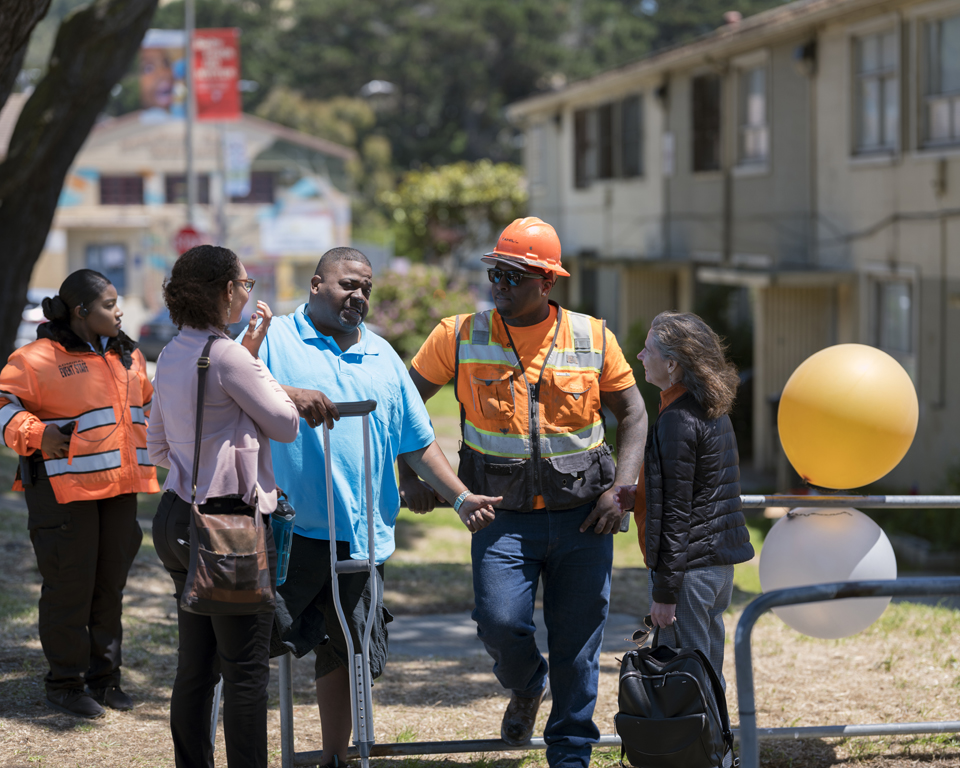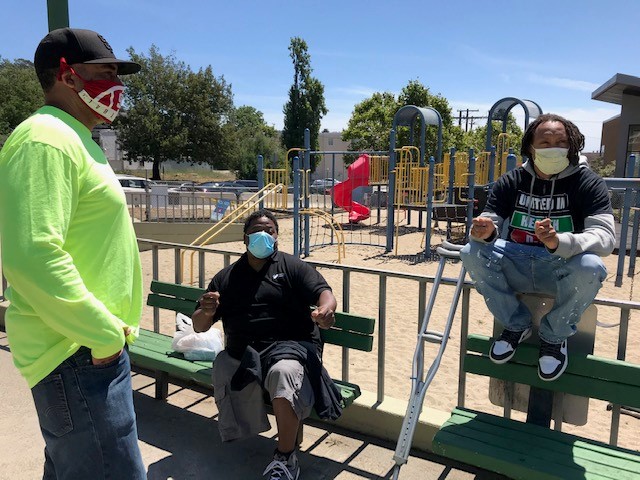A Big Wraparound of Love: How HOPE SF Responded to the COVID-19 Pandemic
 Photo by Bashir Anastas
Photo by Bashir AnastasSince the coronavirus pandemic started, Larry Jones hasn’t taken a day off of work. As a senior community liaison for Mercy Housing, Larry has his ears to the streets in Sunnydale, San Francisco’s largest public housing community. He helps ensure supplies are delivered to families in need, educates residents about COVID-19, makes wellness checks, performs contact tracing, and so much more.
“COVID is my enemy. I live COVID every day. I think about COVID — like I brush my teeth thinking about COVID — because it’s just so dangerous and until there’s a cure or we get a grip on it, it’s just going to keep running wild.”
Larry has worked for Mercy Housing for 13 years, but he has also lived 44 of his 46 years at Sunnydale and knows it intimately. He is one pivotal part of an ecosystem of residents, community-based organizations, and government entities that serve HOPE SF.
With residents like Larry on the ground and staff in the mayor’s office, the unique multi-partner infrastructure of HOPE SF helped it respond quickly to the pandemic. The partners have worked side-by-side for years, building up trust, rapport, and a shared vision of safe and healthy communities.
“Every day is just a big, big collaborative over here. And everybody plays a cog and it’s just really sweet to watch it work when it’s working great. It looks really smooth,” Larry says
 Photo by HOPE SF Staff. Larry Jones at UCSF Testing event in Sunnydale.
Photo by HOPE SF Staff. Larry Jones at UCSF Testing event in Sunnydale. “When COVID-19 arrived in the United States, San Francisco was one of the first cities to respond, issuing an emergency declaration to create a containment strategy before a single case had been confirmed.”
When COVID-19 arrived in the United States, San Francisco was one of the first cities to respond, issuing an emergency declaration to create a containment strategy before a single case had been confirmed. Knowing that racial disparities mean that low-income communities would be hardest hit, the city mobilized resources for public housing residents.
“It’s hard to shelter in place, especially around here, when you don’t have money and you don’t have things to really keep you busy,” Larry says. “You don’t have all the amenities to stay busy as a normal household would.”
The Friday before the City’s March shelter-in-place order, community-based organizations within the HOPE SF ecosystem worked together to assess resident needs. The staff of these organizations, many of them residents themselves, called households to ask them about childcare, food, internet access, and other needs.
“It’s hard to shelter in place, especially around here, when you don’t have money and you don’t have things to really keep you busy”
HOPE SF also established daily calls between resident leaders, over 55 organizations, and city departments, including the mayor’s office, the health department, and the school district, to keep everyone informed and in communication about the city’s COVID-19 cases and ways to support residents. These 30-minute Zoom calls now take place twice a week. While the format of these calls is simple they’re powerful in that they changed the way information flowed. Everyone — from Larry to the mayor — has an equal voice on these calls.
Together, the HOPE SF collective:
– Prevents the spread of COVID-19 through reoccuring testing and outreach across all HOPE SF sites. To date, more than 3,100 tests have been conducted across the sites.
–Delivers meals, groceries, and supplies to residents. At least 30% of HOPE SF households are unable to shop or to afford basic needs and supplies.
–Coordinated with SFUSD to provide laptops, books, and school supplies to students. In addition, provides support with navigating distance learning, parent organizing, and supplemental literacy materials.
-Ensures residents have access to reliable free internet or hotspots through SFUSD, in collaboration with Comcast
– Established the HOPE SF Relief Response Fund to help residents who have experienced a loss in income pay for rent, medical expenses, and bills.
-Assist residents in applying for unemployment insurance and stimulus income. Also, heightened financial coaching, in partnership with Smart Money Coaching, to help plan for the months ahead.
-Prevents evictions through a data-tracking tool to alert property managers to households that need help before they are at risk of eviction.
A lot of the work involves just being out and about in the community, connecting people to resources, and educating residents about COVID-19 (in a socially-distanced way, of course). Community leaders like Larry dispel rumours, encourage testing, hand out PPE, and give tips on how to properly mask up.
“When you wear a mask, you protect yourself,” Larry says. “You have three holes in your face: your mouth and your nostrils. Protect them! The minute you take it down and you’re not at home, you’re at risk of being infected. You got to think that way! You have to think the worst and accept the best.”
When a teenager tested positive in juvenile hall and came back to Sunnydale, community leaders were alarmed because they knew he hung out with many friends. The teen was asymptomatic.
“There was no shortness of breath, coughing, sweats, body aching,” Larry says. “This kid was normal, as were all of his friends.”
Because of the HOPE SF infrastructure, Larry and his colleagues were able to call the San Francisco Department of Health and Theo Miller, the director of HOPE SF in the mayor’s office, and get a pop-up testing site set up.
When positive tests came back, “we sprang into action and we just did traces as to who hangs with who and who goes where, and we were able to put the puzzle together. It took maybe two or three weeks, but we got everybody quarantined,” Larry says.
This fast response and diligent contact tracing helped slow the spread. The most recent round of testing revealed no positives.
Though the work is nearly all-consuming, Larry knows he’s not alone. He’s working with others like him who care deeply about their community.
“It’s just this is a big wraparound of love out here. I love this community,” Larry says.
“While HOPE SF is working hard to meet the moment around COVID-19, it is also maintaining its long-term focus on community development and access to opportunity.”
While HOPE SF is working hard to meet the moment around COVID-19, it is also maintaining its long-term focus on community development and access to opportunity. Construction continues at HOPE SF sites, especially in Sunnydale where hundreds of new apartments are going up. HOPE SF is also moving forward with an economic inclusion taskforce with residents and leaders to contemplate policy changes, resource allocation, and innovative strategies that close the racial wealth gap. If anything, the pandemic has only made these inequities clearer and underscores HOPE SF’s priority of addressing disparities.
“The fact of the matter is that the pandemic exposed what we knew before shelter in place — our systematic exclusion of certain families for generations, leaving HOPE SF communities under-resourced and overexposed to continual public health crises,” says Theo Miller, HOPE SF Director in the Office of the Mayor. “And yet our communities have shown their extraordinary resilience and innovation, leading city, philanthropic and community partnerships in ways that beat back this virus, give us hope for our futures, and strengthen our families and neighborhoods for the long haul.”

